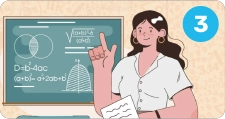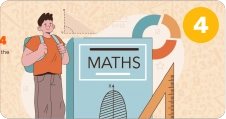Chalana-Kalanabhyam is the Sanskrit phrase used in Vedic Mathematics. It means “by movement and by position.” It is one of the sixteen Sutras, or word formulae, presented by Sri Bharati Krishna Tirthaji in his book “Vedic Mathematics,” and he claimed each of them to represent a mathematical principle. Chalana-Kalanabhyam Sutra mainly applies for simplifying some specific algebraic equations, particularly quadratic and cubic ones. If you are interested in such topics, here are some level Chalana-Kalanabhyam vedic maths workbooks for students.
Recommended Reading: HOW VEDIC MATH CAN HELP GEN Z TO OVERCOME MATH FEAR
Let us consider an example of how the Chalana-Kalanabhyam Sutra can be used to solve cubic equations by chalana math.
Consider the cubic equation
x^3 – 6x^2 + 11x – 6 = 0
Solve this cubic equation by using Chalana-Kalanabhyam
- First, observe the coefficients of the equation: 1 (for x^3), -6 (for x^2), 11 (for x), and -6 (the constant).
- Begin with the assumption that the root of the equation is ‘x.’ Consider ‘x’ and begin by subtracting the coefficient x^2 from it, that is, x – (-6) = x + 6.
- Now, multiply this root with the coefficient of x, which is 11, and subtract the constant term, which is -6. This will give you the expression (x + 6)*11 – 6.
- If the result of this operation is zero, then you have found a root of the cubic equation. But in this case, you will find that for x = 1, the result is indeed zero, so x = 1 is a root of this cubic equation.
- The other roots can be obtained by factoring the original cubic equation using (x – 1) that would leave a quadratic equation and solve it as usual.
This is an illustration of how Chalana-Kalanabhyam can be applied to the solution of the cubic equation. However, note that the use is limited to this sutra and it’s not applicable to all types of equations. To learn more about this, one can go deeper into the concept of chalana math in English for a better understanding of practical applications and limitations.
FAQ’s
1. What is the origin of Chalana Kalanabyham?
It is one of the nikhilam sutra 9×16 (aphorisms) of Vedic Mathematics, which originated from ancient Indian scriptures.
2. How is Chalana Kalanabyham applied in mathematics?
It is mostly used to solve algebraic equations, calculate squares, and reduce multiplication, particularly when numbers are close to a base value, such as 10, 100, or 1000.
3. What are the benefits of using Chalana Kalanabyham?
- It makes calculations easier.
- Less time is consumed in solving arithmetic problems.
- The accuracy is more if it is practiced correctly.
Moonpreneur understands the needs and demands this rapidly changing technological world is bringing with it for our kids. Our expert-designed Advanced Math course for grades 3rd, 4th, 5th, and 6th will help your child develop math skills with hands-on lessons, excite them to learn, and help them build real-life applications.
Register for a free 60-minute Advanced Math Workshop today!


















What are the 5 rules of Vedic Maths?
There are 5 basic rules of Vedic Maths; Nikhilam Sutra, Gyarasguna Sutra, Ekanunena Purneva Sutra, Antyaordasake Pi, and Navamguna Sutra. These rules deal with the multiplication operation.
How powerful is Vedic Maths?
Vedic math offers quicker mental calculation methods, subject to individual preference. Adoption in mainstream education varies, with opinions on its effectiveness differing among individuals.